
The M3A1 Grease Gun saw service at the very end of the Second World War. The earlier M3 entered combat in Europe on D-Day.
On a cold day in January of 1945, an American Infantry Private named Bob Shine was ordered to assault uphill to seize a fighting position occupied by three young German Volkssturm troopers near Salmchateau, Belgium. Shine and two comrades quickly prepared for the mission. These three troopers typically carried .30-06 M1 rifles but appreciated that these long heavy weapons would be less than ideal tools for a chaotic close-range assault. Trading among other members of their unit all three took up M3 Grease Guns. The greasers were relatively new and ugly as sin, but they could be relied upon to provide a proper volume of heavy automatic fire.
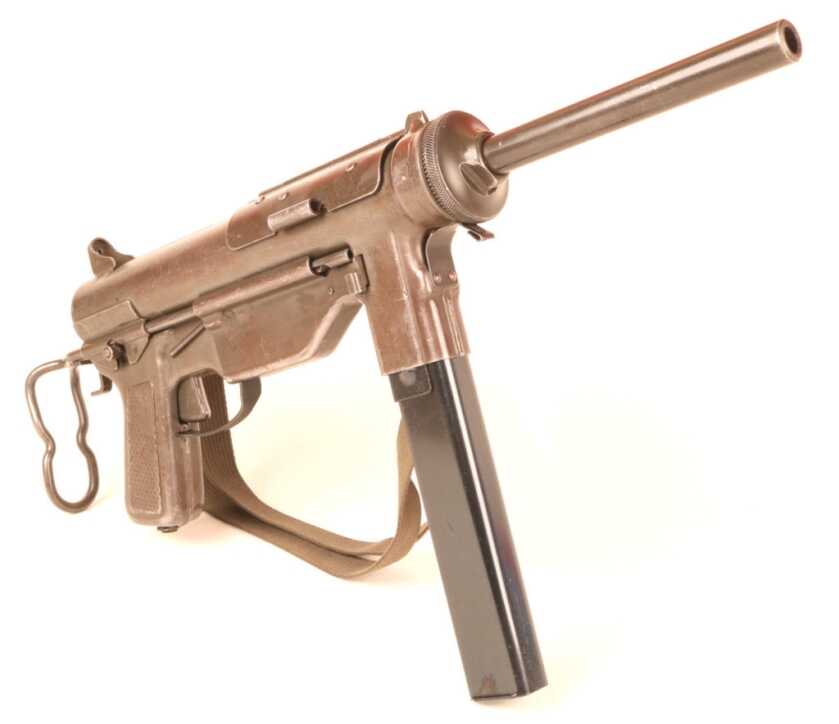
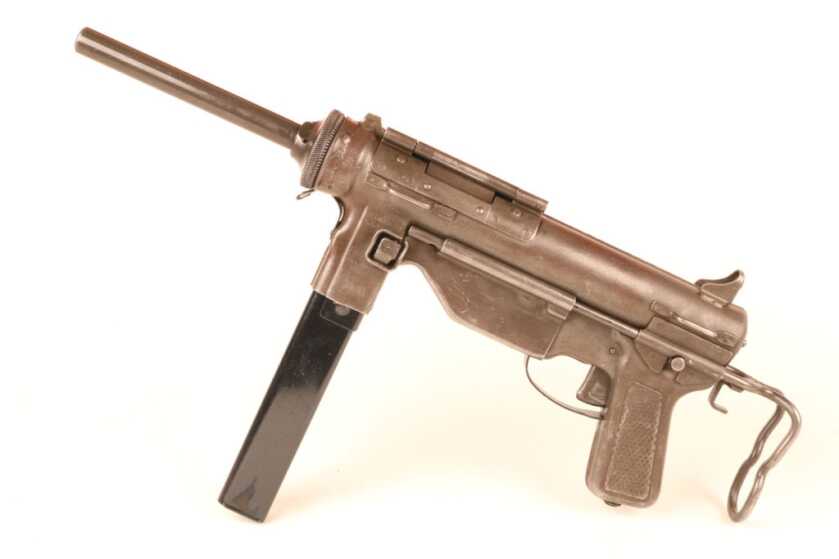
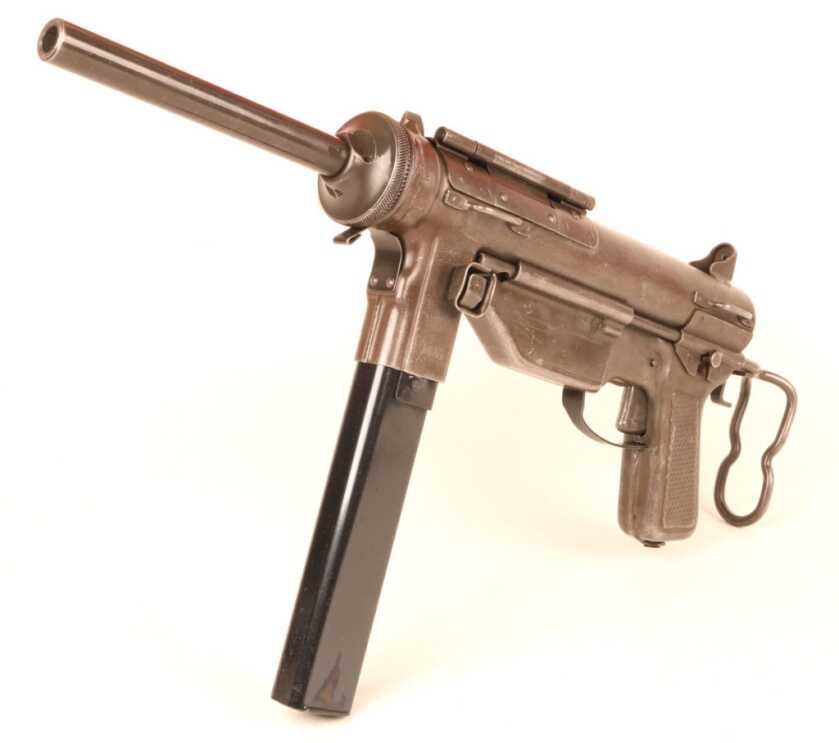
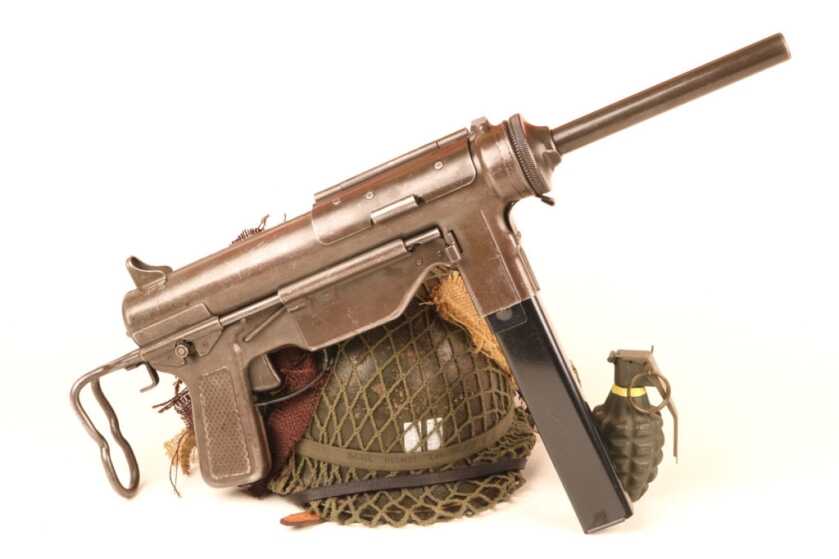 Advancing against blistering fire from German automatic weapons, Private Shine and his two buddies fired their Grease Guns in short bursts on the run, swapping magazines as they moved. In their frenzied rush up the hill Shine and his mates severely wounded all three German defenders. Once astride the position the three Americans finished them off with bursts from their Grease Guns before the rest of their unit caught up.
Advancing against blistering fire from German automatic weapons, Private Shine and his two buddies fired their Grease Guns in short bursts on the run, swapping magazines as they moved. In their frenzied rush up the hill Shine and his mates severely wounded all three German defenders. Once astride the position the three Americans finished them off with bursts from their Grease Guns before the rest of their unit caught up.
These new American submachine guns had been devastatingly effective at close range, but Shine and his buddies had also been very fortunate. The three young German soldiers bled out and died for a doomed and blighted cause on this forgotten Belgian hillside. In their own way, the dark events that surrounded these six young men on that one bleak day encapsulate the pathos and horror that characterized the Second World War.
Origin Story

The Thompson submachine gun was the impetus behind the development of the Grease Gun. Crazy heavy and shockingly expensive, the Thompson was actually obsolete before the war began.
The Thompson submachine gun was obsolete by the outbreak of World War II, but it was the only tool at hand. Sinfully heavy and just stupidly expensive, we still produced 1.5 million copies by the time production ceased. A Tommy gun cost the government about $225 at the beginning of the war. That equates out to about $3,700 today. Compare that to $85 for an M1 Garand, and $45 for a carbine. We simply had to do better.
George Hyde of General Motors’ Inland Division began work on the M3 submachine gun in October of 1942 as a replacement for the Thompson. The stamped steel gun he developed was universally referred to as the Grease Gun based on its esoteric similarity to this common mechanic’s tool. By the time production really got rolling these utilitarian weapons cost Uncle Sam about $18 apiece.
 The M3 was optimized for mass production. The receivers were constructed of two pressed steel clamshells welded together. This component did little more than enclose the action and yielded a gun that was remarkably forgiving of battlefield grime. The bolt rode on a pair of guide rods, and the gun fired via advanced primer ignition. This means there was a simple dimple machined into the bolt face that served as a firing pin.
The M3 was optimized for mass production. The receivers were constructed of two pressed steel clamshells welded together. This component did little more than enclose the action and yielded a gun that was remarkably forgiving of battlefield grime. The bolt rode on a pair of guide rods, and the gun fired via advanced primer ignition. This means there was a simple dimple machined into the bolt face that served as a firing pin.
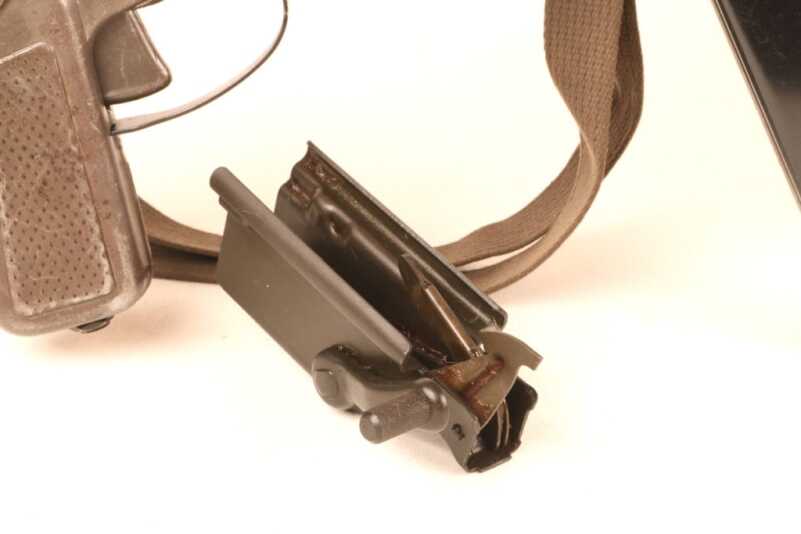
The earlier M3 employed an overly complex ratchet system for charging the gun. The later M3A1 did away with this superfluous device.
The Grease Gun was full auto only. However, the rate of fire was so slow that singles were readily possible so long as attention was paid to the trigger. The M3 used a tapered double stack, single feed magazine, and this was its greatest weakness. The same design was used in the British Sten gun and German MP40. These magazines were hard to load and susceptible to fouling. By contrast, the double stack magazine used by the Thompson was hugely better.

The pressed steel pistol grip on the Grease Gun was badly oversized. Additionally, the sliding stock eats uncomfortably into your wrist when collapsed. The angled bit of steel built into the stock is an inspired magazine loading device.
The original M3 incorporated a relatively flimsy and complicated ratchet mechanism for charging. The subsequent M3A1 did away with this cocking lever in favor of a simple divot in the bolt for the firer’s finger. The later model incorporated a serviceable magazine loader into the gun’s wire stock as well. The first use of the Grease Gun in combat in Europe was purportedly during the D-Day invasion in 1944. Around 700,000 copies were eventually produced.

The ratchet mechanism of the M3 Grease Gun was prone to damage. An ingenious field modification involved removing the inoperative ratchet components and milling a longitudinal slot in the receiver to accept a simple steel charging handle.
The Grease Gun was originally intended to be disposable, so spare parts were not maintained in inventory. If something broke you were to run over the gun with a tank and go draw a replacement. However, innovative local armorers found a clever solution to getting M3 guns back in action if their ratchet mechanisms failed. In this circumstance, the ratchet components were removed and a slot milled along the top right aspect of the receiver. The bolt was then drilled to accept a simple rigid charging handle. Several of these field-converted guns turned up in Luxembourg after the war.

The Grease Gun was never as popular with American troops as was the Thompson. However, it fought all the way across Europe and was really the more efficient combat implement of the two weapons.
Practical Tactical
The pistol grip on the M3 Grease Gun is not designed for real humans, and the wire stock grinds into the wrist mercilessly when collapsed. When extended the stock is stable enough. With the stock extended the Grease Gun is comparably comfortable both from the shoulder and the hip.
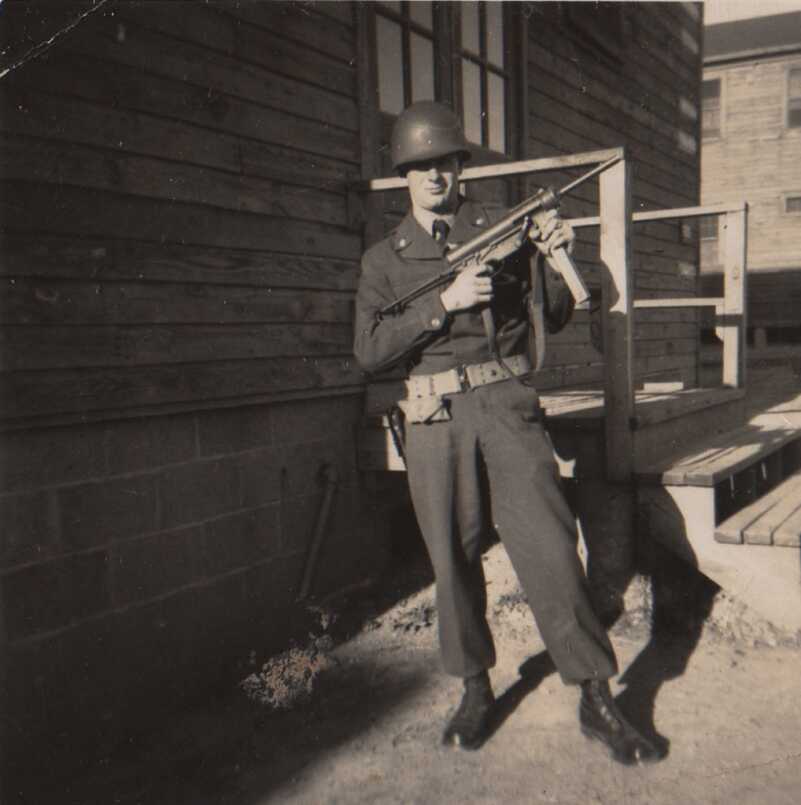
The M3 Grease Gun offered US troops a compact and controllable submachine gun that was reliable in action and inexpensive to produce in quantity.
The sole safety on the gun is comprised of a steel tab on the dust cover that snaps in place to lock the bolt either forward or back. It is awkward to use quickly yet remains serviceable. There is a felt pad riveted into the inside of the ejection port cover. The sights are pressed into the receiver assembly and are subsequently quite fixed and thoroughly rigid.
The sedate 450-rpm rate of fire makes your magazines last a while, a particular benefit should you find yourself dropped behind enemy lines in Normandy with a full auto only gun and no ready source of resupply. The sling points are on the left, as they should be, and the gun accepts a standard carbine sling. Magazines are a holy pain to load even with the magazine loader.
The greaser is fairly heavy, so recoil is painless despite the prodigious .45ACP chambering. The gun is indeed quite compact and maneuvers quickly in tight spaces. The downrange effect at close ranges is undeniably impressive.
Denouement

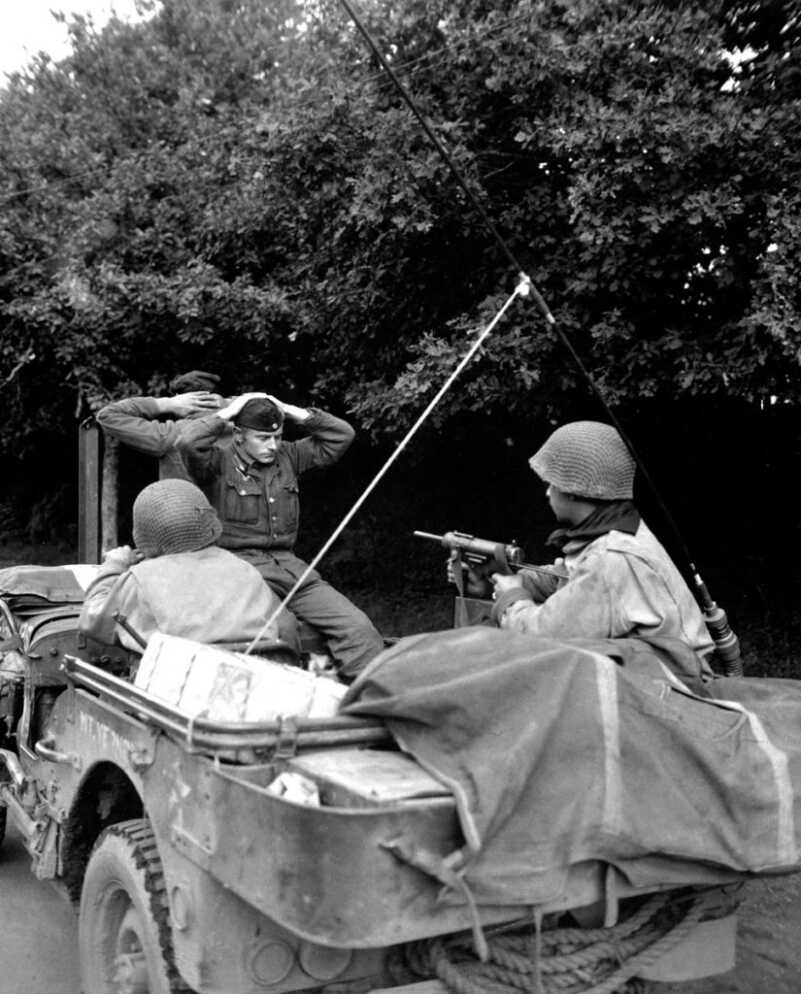
The M3 Grease Gun helped crush the Nazis and went on to serve for more than half a century in the hands of American troops.
There was a 9mm conversion kit developed for the gun to be used by the OSS in occupied areas where 9mm might be the only ammo available. The Grease Gun saw service during the Korean War, and we supplied thousands of these weapons to ARVN forces in Vietnam. Suppressed examples of the Grease Gun were found in the burned-out wreckage of aircraft abandoned in the Iranian desert during the ill-fated hostage rescue attempt in 1980. I frequently encountered Grease Guns in the hands of American armored vehicle crewmen when I was on active duty in the 1990s. A friend carried a Greaser that was off the books throughout the first Gulf War and ultimately buried it in the sand when he couldn’t find an arms room willing to take responsibility for it.
Despite the Grease Gun’s modest purchase price, transferable versions cost a holy fortune today. Relative few of these old guns made it into the registry before the machinegun ban of 1986, and their astronomical purchase prices reflect their rarity. I once met a man who carried a Grease Gun in Vietnam and smuggled it back home after building a lamp out of it in theater.
Ugly, cheap, and functional, the Grease Gun was a simple gun for desperate times. Initially disparaged by those to whom it was issued, most American troops developed a grudging respect for this simple pressed steel battle implement. Despite the weapon’s humble origins the Grease Gun went on to render effective service around the globe in the hands of American soldiers for half a century.
Special thanks to worldwarsupply.com for the period gear used in our article.
Technical Specifications
M3A1 Grease Gun
Caliber .45 ACP
Weight 8.15 lbs
Length (Inches–Extended/Collapsed) 29.8/22.8
Barrel Length (Inches) 8
Rate of Fire (Rounds per Minute) 450
Magazine Capacity 30 rds


Here’s a link to a pic from Quora of an M3 with a curved barrel for shooting out of your tank turret.
https://qph.fs.quoracdn.net/main-qimg-6f22b8d018acf2f757c62ef4569e77fc
Back in the early 70’s I was in a unit that carried the grease gun m3a1, 3rd armored 12th cav in Budigen Germany and those suckers were a blast to fire, but have some problems with the rise of the barrels when you dumped all 30 rounds. So we used toe straps by that you would put a strap around your foot and a strap around the barrel to help stop the rise and it worked out very well, happy shooting you all.
My dad carried an m3 in the bay of pigs invasion. He was in a fire direction center for a mortar battery. He said that they replaced the springs to increase the rate of fire prior to the invasion. They aimed at the target’s left foot and the modest recoil would walk a few rounds across the vitals. No survivors…
RIP Ernesto.
In 1960, I was young Navy hospital corpsman assigned to A Company, 3d Recon Bn. The T.E. weapon most of the Marines of that unit carried was the grease gun. They loved it. It was nearly indestructible, easy to clean and maintain, and easy to handle in our nine-man rubber boats. It was a devastating weapon. It also had another characteristic that the troops really liked: If you removed the bolt, it only weighed about three pounds which was great on a PT run or conditioning hike.
Well done article on an interesting firearm. Always enjoy your artcles
I imagine the three young German troops mentioned in the article were Volksgrenadiers, not members of the Volkssturm. The latter were essentially a conscripted militia force that represented the last gasp of the Third Reich in combat on German soil.
Volksgrenadiers were Wehrmacht troops in decimated divisions, refitted and reorganized in 1944-45 under a new Table of Organization and Equipment (the American term; the Bundeswehr term was or is “STAN”). The new TO&E greatly reduced the demands on scarce manpower posed by Wehrmacht infantry divisions, while seeking to maintain their combat power with a greatly increased proportion of automatic weapons. If I recall correctly, a division’s three infantry regiments each went from three battalions down to two, and I believe a VG division had a seventh maneuver battalion cobbled together somehow–perhaps as a recon battalion.
Most VG divisions were reconstituted from the wreckage of infantry divisions shattered in Normandy and the Falaise Gap, and in the cauldron of the Eastern Front. The honorific “Grenadier” hearkened back several hundred years to European infantry regiments having approximately 8 line companies armed with smoothbore muskets; 1 light company (trained as skirmishers, sometimes armed with rifles); and 1 grenadier company. Grenadiers in the era of siege and fortress warfare employed the small bomb (grenade) with burning fuse, evoked by the US Army Ordnance branch insignia. The French and Belgian armies use the flaming bomb as their infantry insignia.
In any event, a regimental grenadier company in Early Modern Europe typically comprised the sturdiest physical specimens, who could hurl their heavy grenades in the trenches, approaches, and saps (think “Sapper”) that were the stock in trade of attack and defense centered on the great star forts of the 16th-18th centuries. Such action occurred in the assault phase of an approach, so the grenadier companies are properly to be viewed as the assault, shock, or storm troops of that era. The grenadier and light companies were definitely the elite companies of infantry regiments. They were commonly referred to as the “flank companies,” since the light company anchored one flank of the regiment when formed in line of battle, and the grenadiers the other.
The term Volksgrenadier or “People’s Grenadier” in 1944-45 sought to confer a certain feeling of elite status on divisions so designated in the Third Reich’s final year of existence.
The M3 gets a lot of screen time in “Hell is for Heroes.” It’s a rather bleak movie, but worthwhile for the cast, the “angry detached loner” Steve McQueen, and the M3. According to IMDb, the M3 jams were due to the use of blanks.
I thoroughly enjoyed shooting my issue grease gun when I was in the 49th Armor Loan Star division. It was hard to believe it weighed over 8 pounds, is seemed so light and controllable – the ammo was quite heavy though.
I worked at GM in the plant that made the grease gun and actually worked with a woman that worked in machine gun room. She said they test fired them in a pit with oil in it. Plant protection searched u on way in and out. My plant made the 45 single shot pistol also ,was neat that in early 70s when I hired in the WW2 people were still there.
I used to know someone who owned a legal NFA registered Grease gun. It worked but I was unimpressed. The cyclic rate was so slow it was almost like firing a semi auto. If you live in a state where full auto is legal and you are in the market for a sub gun, my advice is to pass on this. It isn’t worth a $200.00 tax stamp.
Back in the early 80’s at Ft Sill, every private was trained to drive an M109 self propelled howitzer. Once arriving at permanent duty station it was a bit of an honor and huge responsibility to be selected as a delta (driver).And drivers were issued M3 Grease Guns.In case there was any doubt-inside the drivers hatch, on the bulkhead were clips.Stenciled in black lettering “M3” is where you stowed it.One had a bit of a swagger walking through base camp.Especially past the tankers who were only issued 1911’s which they wore in shoulder holsters.Big deal-I had a M3 submachinegun! In the 3rd ACR we went to the live fire ranges out in Dona Anna,N.M. a lot.Everybody wanted to shoot the M3.Inaccurate?Naw.If you held just right you could hit the 300m pop up-sometimes!
Good article.
Just as interesting are comments on the experiences from those who’ve served and are familiar with the particular weapon.
Your stories are great and I really enjoy reading them.
Keep commenting, please.
M3s had been supplied to the Afghan National Police in 2003 or earlier. I saw significant numbers of them in the hands of ANP in Kabul and Gardez in 2003, and one was seized from Anti Coalition Militants near Gardez in Regional Command East. Noone had the opportunity to make use of it due to a lack of .45 ACP ammo, which wasn’t available to us even though we were with a Special Operations Task Force. We didn’t have 30.06 ammo for a captured M1 Rifle, either. The M3s had disappeared by the time I was back in 2006. Hungarian AMDs and Czech VZ-58s were far more evident in service with the ANP by then.
I have heard of at least one other M1 Garand found in Afghanistan. I am supposing they come by way of our “friends” in Pakistan. I guess this because I have seen some very grimy looking M2 Ball loaded in enbloc clips sold as Pakistani made surplus from decades ago.
Very good, I am a self proclaimed “Gun Nut” and read most anything on all types of weapons and weapon systems (Yes the big ones) When in the Army I was one of the people that told our 109A1’s where to shoot, and had the chance to pull the lanyard but got pulled to something else (Damn) Keep up the good reads!
Nice detailed historical write up,
I enjoyed it very much.
I’d like to get in touch with the writer to see if he will be interested writing about
Luger 1907 US Army Trial gun.
You can find me on LugerMan.com in case there is interest.
There were a couple of M3s @ our dispensary in Da Nang. I think that they were left behind by wounded ARVN troops we may have treated. I shot off a couple of magazines @ the shooting range, but was always spooked by the short barrel. I was fortunate that as a Hospital Corpsman I never had to engage in any real combat, unlike many of my fellow Corpsman brothers.
Carried an M3A1 in 1960-61 when serving in Marine 2nd Recon Battalion. During maneuvers in Greece saw the Royal Hellenic Raiding Forces, using the earlier model with the charging handle. Both groups liked the dependability and small size with the wire stock closed. We had a few Thompsons in the armories of our guard units in Morocco in 62/63 and although everyone liked the cool look, they were god-awful heavy.
Thanks for a great article, next best thing to having an M3 on the range.
I would kill for a decent, readily available, and inexpensive semi-auto clone
Carried two of these back in my early Armor days. One in the driver compartment and one in the turret. Primarily used when dismounting for LP/OP and eventually phased out for the M4 carbine.
Highly inaccurate and had be within 25 meters or less of target to be effective. Reliable as hell though and took a beating getting thrown around and banged around in a tank.